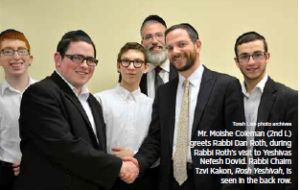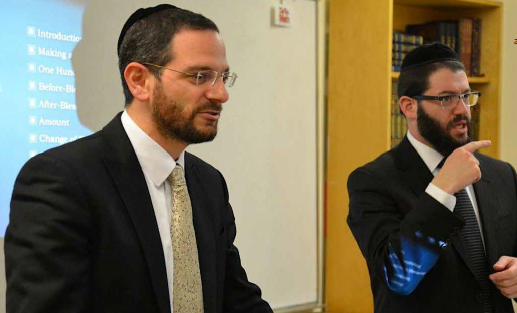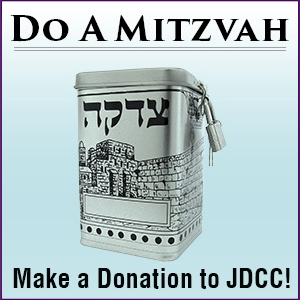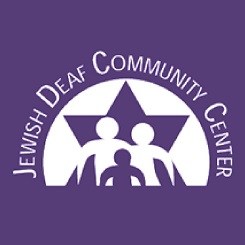Photo: Torah Live photo archives Rabbi Dan Roth (L) giving a presentation at Yeshivas Nefesh Dovid, as Rabbi Yitzchok Wolman (R) interprets in sign language.
BY DEVORAH KLEIN
Hamodia
3 Iyar 5778
Dina Cotton was frustrated. Her friends kept recommending to her to listen to various shiurim online, but because she is hard of hearing, she could not follow the shiurim, and most of them did not include captioning. Determined to implement change, she tried contacting various organizations, but kept being told that it is not offered, that there was no money for it.
“I felt as if I was hitting a brick wall,” Mrs. Cotton recalls. “Finally, I approached JADE in Baltimore, who was receptive to the idea.”
JADE, or Jewish Advocates for Deaf Education, is a program of the Louise D. and Morton J. Maks Center for Jewish Education (CJE) in Baltimore, Maryland, coordinated by Mrs. Yael Zelinger.
Mrs. Cotton told JADE that she especially wanted to listen to Rebbetzin Yemima Mizrachi’s video, together with everyone else in the community. Mrs. Martha Goodman, Coordinator for the Maryland Special Needs Advocacy Program for CJE, stepped forward, taught herself how to caption, and captioned three of Rebbetzin Mizrachi’s videos on a volunteer basis.
Mrs. Cotton was thrilled with the results. “These shiurim were a real blessing for me,” she remarked. “There is a huge need.”
Identifying the Need
Videos and recordings have become part of our lives. Whether we are listening to the ever-popular Chofetz Chaim Heritage Foundation Tishah B’Av videos, a promotional video at a banquet or just an online shiur, countless individuals have been inspired and uplifted by a prerecorded video shiur.
However, for those who are deaf or hard of hearing, these shiurim — and many other video productions — are not accessible. The solution is captioning, which is a growing initiative in the world at large. Fortunately, captioning of Jewish videos is beginning to catch on as well.
Mrs. Zelinger described her efforts to promote Jewish captioning. “Almost a year ago, we started on a journey to promote adding captions to videos with Jewish content. Since then we have met many other professionals and lay people who also feel passionately about this topic, including many adults who do not identify with the deaf community at all. We have done a lot of research, formed a Community of Practice [a group of people who share a craft and/or a profession – Ed.], and even secured a grant from the Center for Jewish Education to help pay for the process of captioning. Baruch Hashem, we have seen some success and found ‘sympathetic ears’ among video producers, and even a teacher in a school in New York who wants to make captioning part of the community service project options for his high school students. Yet, the need for more awareness is acute.” The Community of Practice includes several individuals from various organizations who are interested in promoting Jewish captioning. These include Mrs. Zelinger; Mrs. Cotton; Mrs. Goodman; Mrs. Sharon Shapiro-Lacks, founder of Yad Hachazkah/Jewish Disabilities Empowerment Center; Mr. Moshe Mordechai Tzvi Coleman of Torah Captions; Mr. Louis Caplan, Mr. Yoel Krigsman, Mr. Yisroel Laks, Mrs. Mattice Aaronson, and Mrs. Rachel Turniansky. Mrs. Cotton now volunteers at JADE once a week to help out with the captioning initiative. Mrs. Goodman became passionate about captioning since meeting with Mrs. Cotton. She has done extensive research into the best methods of captioning, and is now very active in promoting it.
Mrs. Zelinger relates that when she asked deaf people what video presentations they would want access to, they did not know how to respond. “We gathered together a group of deaf people to ask them what they would like to see captioned,” relates Mrs. Zelinger. “The room was silent! They did not know what they wanted, because they are not aware of what they are missing! We have gotten used to accessing so many varied types of videos, and they do not even know that they exist.” There are many who can benefit from captioning, besides those with hearing loss. Some people have trouble hearing clearly if there is background noise; others have auditory processing difficulties and do better when they can read the information. Captioning can also be done in different languages, so that those who are not fluent in English can follow more easily. While producers may be concerned that the “typically hearing” viewers will find captions distracting, the real situation is often quite the opposite. Sometimes a listener may have trouble understanding a speaker’s accent, or may lose focus for a few seconds, and the captioning can help. An additional need is that of parents with hearing loss who have hearing children. Without the access that captioning provides, they cannot approve a video; neither can they enjoy it with their children or discuss its content afterward. In the world at large, captioning is becoming the norm, and there are federal may even be a tax deduction for expenses incurred for complying with regulations. It is predicted that within 10 to 20 years, the text-to-speech industry will really take off. It will be a completely different world with so much accessibility for the hard of hearing.
How Does Captioning Work?
There are various options for captioning videos, and costs can vary greatly. Usually, it is really not as complicated as one might think. For about $30 an hour, any video can be transcribed by a trained professional. After the video is transcribed, its text must then be embedded into the video so that the captions appear in the proper places at the proper times, which entails an additional cost. Some video websites have an option for auto-captioning, which a web administrator can enable. (The drawback is that commonly used captioning software tools fall short when it comes to translating Hebrew terms. However, if there is an option for community settings,
any knowledgeable viewer can adjust the captions. Captions do not become public until the owner of the video approves.)
Software tools are available that convert speech to text. As with auto-captioning on websites, mixing English and Hebrew terms makes the process more complicated. Mrs. Goodman is researching various tools and lexicons that can be inserted into available software to enable proper captioning. Organizations that regularly record shiurim and lectures and post them online can lease the software for specified periods of time — by the hour or by the month, for example — and use this software to caption their recordings.
The Access Grant
JADE is now offering a special grant, the Access Grant, in which the first 10 organizations to qualify will be eligible to have $100 worth of subsidized captioning. Until now, JADE sponsored an interpreter fund, which offered grants to help pay for sign language interpreters at various local shiurim. Now, this fund has expanded into an Access Fund, and an organization that is producing a video can apply for funding for captioning. In order to qualify for the grant, the video must have Jewish content, and the money is paid directly to the captioner. A typical one-hour video can be professionally transcribed in a little over three hours at the rate of $30 an hour.
Torah Captioning
Mr. Moishe Mordechai Tzvi Coleman is a graduate of Yeshivas Nefesh Dovid in Toronto, a unique yeshivah for bachurim with hearing loss. He has been working hard to promote the concept of captioning of Jewish videos through his organization, Torah Captions. He relates, “My goal is to get organizations to consider captioning for their videos. Often, their hesitation is due to the time and money involved. The only way to get them to agree is by doing fundraising on their behalf for this purpose. Often, these productions have many sponsors, so why not get an additional sponsor for the captioning? There are many details involved, but I am working
together with Mrs. Yael Zelinger of JADE to identify the easiest and most economical method of captioning. The Access Grant that she has developed is a great way to get organizations willing to try it, and then hopefully, they will continue on their own, so that no one is left out. Now, I can go back to the organizations that I originally contacted and suggest that they apply for the Access Grant.” Mr. Coleman relates that some organizations have agreed to caption videos, but would like to see a real demand before continuing to use the captioning. For example, one organization that produces DVDs for children captioned two videos. They are waiting to see how many people are actually interested in the captioned videos before producing more.
Success Stories
Rabbi Dan Roth is director of Torah Live, an organization dedicated to producing high-quality multimedia presentations about Judaism for both adults and children by creating cutting edge multimedia presentations that communicate halachos and Jewish values in a friendly, well organized and energetic manner. Rabbi Roth is determined to make his videos accessible to as many people as possible; many of them include an option for captioning. “Several years ago, I was visiting Toronto, and met Reb Moshe Coleman, who reached out to me to give a presentation in his yeshivah, Yeshivas Nefesh Dovid. It was the first time that I gave a shiur to those with hearing loss. Someone was standing next to me, interpreting my lecture into sign language, and it was a very moving moment for me. Since then, Reb Moshe has been very encouraging and instrumental in helping us get funding to be able to include captioning in our videos. He is doing great work, and we are happy to be involved.”
He is doing great work, and we are happy to be involved.” Another organization that has been enthusiastic about captioning its videos is The Torah Legacy Foundation. This non-profit organization, which is under the direction of Mr. and Mrs. Elan Sloan, produced Triumph of the Spirit, a popular video about Harav Nosson Tzvi Finkel, zt”l, Rosh Yeshivah,Yeshivas Mir, Yerushalayim. Mr. Sloan related, “After we saw how much of an impact the film about Rav Finkel had on people, we wanted to reach even more audiences and decided to release a second version with captions in English, Russian, and Spanish. The videos are closed-captioned, which means that the film can be viewed with or without the captions.
“There are two main parts to the captioning process. One is the actual transcribing of the video, and the second is coding the text so that the software can insert the captions into the appropriate places in the video (called encoding or embedding). When we captioned the video on Harav Finkel, we transcribed it ourselves, and then worked with a company in Eretz Yisrael who did the encoding, which involved an additional cost. Recently, in honor of the 30th yahrtzeit of Harav Yaakov Yitzchok Ruderman, zt”l, Rosh Yeshivah, Yeshivas Ner Yisroel, Baltimore, and in conjunction with Ner Yisroel’s annual dinner, we transcribed some relevant archival footage, translated from Yiddish, and inserted captions for a short video about Rav Ruderman. “We are now putting the finishing touches on our next video, Pillar of Truth, an inspiring film on the life and legacy of Harav Yaakov Weinberg, zt”l, Rosh Yeshivah, Yeshivas Ner Yisroel, Baltimore. We recently hired a professional stenographer who transcribed the film, thanks in part to a grant from JADE, and hope to start the encoding process shortly, which will cost [an] additional few hundred dollars. We wanted to include the captions in order to share the inspiration and legacy of the Rosh Yeshivah with as many people as possible.”

The Chofetz Chaim Heritage Foundation has been captioning their popular Tishah B’Av video for several years, and it is available upon request. In Baltimore, in previous years, the captioned version was shown at the Jewish Community Center, separate from the main showing. However, this past year, captions were included in the video shown at the main event. This is greatly preferable, as those with hearing loss — or who need captions for other reasons — can be a part of the community as a whole. This past year, for the first time, Rabbi Yissocher Frand’s Annual Teshuvah Drashah was captioned in Baltimore. With the help of a generous grant, and using state-of-the-art technology called CART (Communication Access in Real Transcription), Rabbi Frand’s words appeared on a huge screen as he was speaking.
Photo: Torah Live photo archives Mr. Moishe Coleman (2nd L) greets Rabbi Dan Roth, during Rabbi Roth’s visit to Yeshivas Nefesh Dovid. Rabbi Chaim Tzvi Kakon, Rosh Yeshivah, is seen in the back row.
The Attitude Shift
Mrs. Sharon Shapiro-Lacks, executive director of Yad HaChazakah/JDEC, has been working for years to get organizations to caption their videos, but has often encountered great resistance. Her goal is to see captioning readily available on every video that is produced. “There is a certain resistance and fear to trying something unfamiliar,” she asserts. “Instead of hearing, ‘We can’t do it; we don’t have capacity or the money,’ I would love to hear, ‘This is important. Thank you for bringing this to our attention. It is a shame that Torah is not getting to people with hearing loss and auditory processing difficulties. Let’s work together to see how we can make this happen.’
For more information on Jewish captioning JADE or Yad HaChazakah, please contact the Hamodia office.
Day of Captioning
As part of her mission to promote captioning, Mrs. Goodman organized a “Day of Captioning” on Sunday, April 15, in conjunction with the Good Deeds Day, sponsored by The Associated. An event was held at the Park Heights Jewish Community Center in Baltimore, as well as in Hillel Houses in Northern Nevada; Rochester, New York; and at Brown University in Providence, Rhode Island. Volunteers were trained in captioning, and then mostly worked on fixing auto-captions on You Tube videos. Approximately 25 volunteers worked on hours of videos.
Mrs. Goodman was very pleased with the turnout, and was excited about the results. “The volunteers were very dedicated. They worked very hard and expressed that they would want to continue and caption more videos. Several volunteers mentioned that they would finish up the work on their own time. They gained a lifelong skill, and this was the real goal of the afternoon.” The real impact of the event is to start a revolution, raising awareness for the need for Jewish captioning, and training volunteers who are capable of captioning, empowering them to help out others who need this service.




